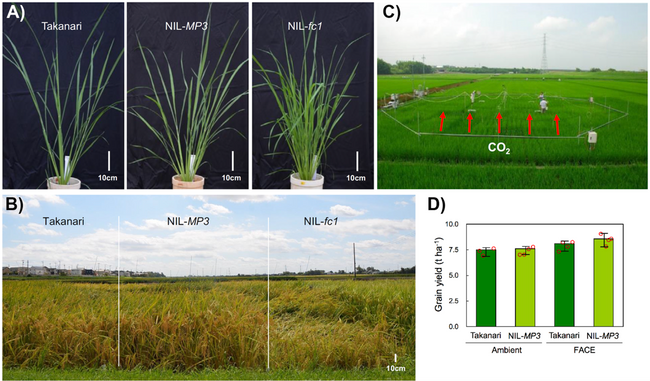TPJ Editor choice: Don’t panic any more: MORE PANICLES 3 increases rice yield at elevated CO2 levels
Don’t panic any more: MORE PANICLES 3 increases rice yield at elevated CO2 levels
Refers to: MORE PANICLES 3, a natural allele of OsTB1/FC1, impacts rice yield in paddy fields at elevated CO2 levels
Climate models predict a rise in CO2 level by 2100, correlated to more extreme weather events such as droughts, storms and flooding. Although increased CO2 levels have negative effects on ambient temperature, they have a positive impact on plant growth by increasing the photosynthesis rate, known as the CO2 fertilization effect. However, the potential of adapting crop plants to higher CO2 levels and thereby increase their production has not yet been fully exploited by breeding programs. Boosting the sink capacity, which is a product of both spikelet number and seed size, could be a key factor for higher yield under elevated atmospheric CO2 levels. However, high yielding rice varieties already produce large panicles, so further increases in panicle size is not considered feasible.
Instead, Takai et al. addressed panicle number in an attempt to increase sink capacity. They focused on the quantitative trait locus MORE PANICLES 3 (MP3). The Koshihikari allele of MP3 in a nearly isogenic line (NIL) in the Takanari genetic background produced more panicles and spikelets, as well as more tillers and more elongated axillary buds at the axil of the second leaf, suggesting that the increased tiller number was caused by a different elongation rate of axillary buds.
To clone the causal gene underlying the QTL, the authors used high-resolution mapping on segregating F2 plants and subsequent recombinant F3,4 lines. They found only one predicted open reading frame in the candidate region, TEOSINTE BRANCHED1/FINE CULM 1 (OsTB1/FC1). OsTB1/FC1 is a TCP transcription factor that is a negative regulator of tiller bud outgrowth. The authors analysed the expression pattern of OsTB1/FC1 and detected expression in the axillary buds, but saw no difference in expression level between Takanari and NIL-MP3. However, by collecting transcriptome data of the shoot apical meristem and axillary meristem at various time points and analysing the expression trajectories, they found that NIL-MP3 reached a more advanced growth stage on the trajectory than Takanari, suggesting that MP3 acts positively on the axillary bud growth.

Figure 1: MP3 affects tillering in rice and grain yield under elevated CO2 conditions.
A) Takanari, NIL-MP3 and NIL-fc1 plants grown in pots.
B) Takanari, NIL-MP3 and NIL-fc1 plants grown in a paddy field in the late grain filling stage.
C) FACE plot with the CO2 emission tubes in an octagonal arrangement.
D) Grain yield of Takanari and NIL-MP3 under ambient and elevated CO2 (FACE) conditions; figure modified from (Takai et al., 2023).
MP3 had three polymorphisms in the 5’UTR, coding sequence (CDS), and 3’ UTR, so the authors tested their importance by identifying different combinations in chromosome segment substitution lines with the Koshihikari background. They found that all three polymorphisms were necessary for the panicle number difference. Perhaps these polymorphisms lead to an alteration in translational efficiency and protein structure, and thereby cause a moderate increase in the panicle number without decreasing the number of spikelets per panicle.
Analysis of haplotypes in a rice SNP database showed that the Koshihikari allele accounted for 74 % of accessions in temperate japonica subgroups, while the Takanari allele accounted for 50–59 % of accessions in indica subgroups. This prompted the authors to introduce the Koshihikari MP3 allele as NILs into two high-yielding indica cultivars, Hokuriku 193 and IR64, which are categorized as Takanari MP3 haplotypes. Phenotyping under field conditions confirmed that the NILs developed a greater number of tillers and a similar number of spikelets per panicle as the parental cultivars.
The previously characterised OsTB1/FC1 allele was derived from a loss-of-function allele in the fc1 mutant, which had a 1-bp deletion in the CDS, resulting in a premature stop codon. When the authors compared a NIL with this allele in the Takanari background with the Takanari wild type and the mild NIL-MP3 allele, they found that the NIL-fc1 produced more panicles, and overall more spikelets per m2 than Takanari. Nevertheless, the grain yield in Takanari-fc1 was much lower than that in the Takanari wild type because the plants lodged during the grain-filling period, i.e. the stems bent near the ground level, because they were thinner and lighter than wild type stems.
Even though the NIL-MP3 increased the number of panicles and number of spikelets per m2, it did not increase the overall yield. The authors hypothesized that this was caused by limited photosynthetic capacity that was not sufficient to fill the spikelets. Therefore, they compared the yield under normal air and free-air CO2 enrichment (FACE) treatments in open paddy fields, in which CO2 is supplied from tubes installed around the experimental plots above the rice canopy. The NIL-MP3 had a higher sink capacity than Takanari in both CO2 conditions, and under higher CO2 conditions, the yield of NIL-MP3 was significantly higher than the yield of Takanari.
In conclusion, the authors propose that mild alleles such as MP3, which moderately increase panicle number, combined with large-sized panicle varieties can be used for creating high-yielding varieties adapted to rising CO2 levels.



